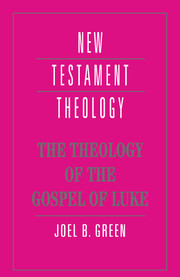Book contents
- Frontmatter
- Contents
- Editor's preface
- Preface
- List of abbreviations
- 1 “In the days of King Herod of Judea”: the world of Luke's Gospel
- 2 “God my Savior”: the purpose of God in Luke's Gospel
- 3 “A Savior, who is the Messiah, the Lord”: Jesus, John, and the Jewish people
- 4 “To proclaim good news to the poor”: mission and salvation
- 5 “Let them take up the cross daily”: the way of discipleship
- 6 “That you may know the truth”: Luke's Gospel in the church
- Further reading
- Index of biblical texts
- Index of modern authors
- Index of subjects
3 - “A Savior, who is the Messiah, the Lord”: Jesus, John, and the Jewish people
Published online by Cambridge University Press: 05 June 2012
- Frontmatter
- Contents
- Editor's preface
- Preface
- List of abbreviations
- 1 “In the days of King Herod of Judea”: the world of Luke's Gospel
- 2 “God my Savior”: the purpose of God in Luke's Gospel
- 3 “A Savior, who is the Messiah, the Lord”: Jesus, John, and the Jewish people
- 4 “To proclaim good news to the poor”: mission and salvation
- 5 “Let them take up the cross daily”: the way of discipleship
- 6 “That you may know the truth”: Luke's Gospel in the church
- Further reading
- Index of biblical texts
- Index of modern authors
- Index of subjects
Summary
For Luke–Acts, the controlling aim is that of God. But the central character within the Gospel narrative is Jesus of Nazareth, whose prominence is a function both of his commitment to God's purpose and of his status as the one through whom that purpose is articulated and realized. As the Song of Mary has it, even the news of the imminent birth of Jesus is enough to secure the affirmation that God's salvation has already begun (1:46–55).
This identification of Jesus with God's purpose is not unexpected in a Gospel that highlights so pervasively Jesus' status and role as Son of God. Although Luke was free to develop this appellation in his own way within the narrative, the term “son” (uios) as it circulated in antiquity would already have suggested certain nuances.2 These included the son's obedience to his father, the father's role as primary educator of his son, and the son's service as his father's agent, his surrogate. In fact, Luke builds his perspective on Jesus on the foundation of these ways of understanding sonship. For him, Jesus' role as God's Son was characterized by his allegiance to God's purpose and his service as God's envoy.
Beginnings are important, and the first two chapters of the Third Gospel begin already Luke's agenda of defining the significance of Jesus. He does this in at least two ways: first, by the way he has structured the birth narratives; second, by his focus on the status of Jesus as God's Son.
- Type
- Chapter
- Information
- The Theology of the Gospel of Luke , pp. 50 - 75Publisher: Cambridge University PressPrint publication year: 1995



